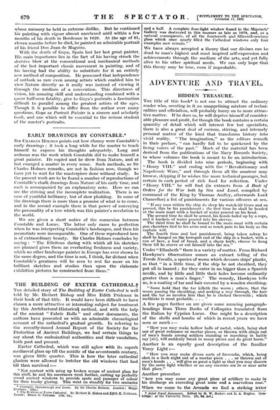THE BUILDING OF EXETER CATHEDRAL.f THE detailed story of The
Building of Exeter Cathedral is well told by Mr. Herbert Bishop and Miss Edith Prideaux in
their book of that title. It would have been difficult to have chosen a more attractive or interesting subject for treatment by this Architectural-Historical) method, and with the help of the ancient " Fabric Rolls " and other documents, the authors have presented us with an admirable chronological account of the cathedral's gradual growth. In referring to the- recently-issued Annual Report of the Society for the Protection of Ancient Buildings, we had certain things to say about the ecclesiastical authorities and their vandalism, both past and present.
Exeter Cathedral, which was still aglow with its superb mediaeval glass up till the middle of the seventeenth century, was given little quarter. This is how the later cathedral glaziers were allowed to butcher the old windows that had till then survived :—
" Not content with using up broken scraps of ancient glass for this stuff, he and his successors went further, cutting up perfectly sound ancient windows to provide spots and passages of colour for their trashy glazing. This went on steadily for two centuries • Constable, Gainsborough and Lucas. By Sir Charles Holmes. London:, Beggs Brothers. ' Ms.] The Building of Execs Cathedral. By Herbert E. Bishop and Edith $. Prideaux. Exeter lames G. 'Commix'. 110s. and a half. A complete four-light window found in the Minstrels' Gallery was destroyed in this manner as late as 1878, and, as a natural consequence, of all the fourteenth and fifteenth-century glass which once nearly filled the Cathedral windows only four examples now remain."
We have always accepted a theory that our divines can be dead to man's highest and most inspired self-expression and achievements through the medium of the arts, and yet fully alive to his other spiritual needs. We can only hope that this theory may be true, even if improbable.


























































 Previous page
Previous page